Navigation
Thousands of Hectares of Tropical Forest are Saved
Thousands of hectares of tropical dry forests in the Brazilian state of Minas Gerais are now safe from logging, thanks to scientists affiliated with a project called Tropi-Dry.
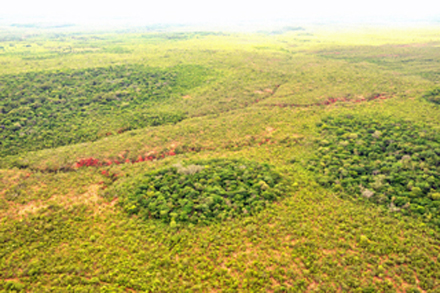 |
| Dry forest islands in a sea of Brazilian savanna, called cerrado, unique to Brazil. Photograph by Arturo Sanchez-Azofeifa |
Thousands of hectares of tropical dry forests in the Brazilian state of Minas Gerais are now safe from logging, thanks to scientists affiliated with a project called Tropi-Dry.
Using information from Tropi-Dry, the members of the Superior Court of Minas Gerais unanimously overturned a state law that altered the status of more than 16,000 square kilometers (6,000 square miles) of tropical dry forests, leaving them unprotected.
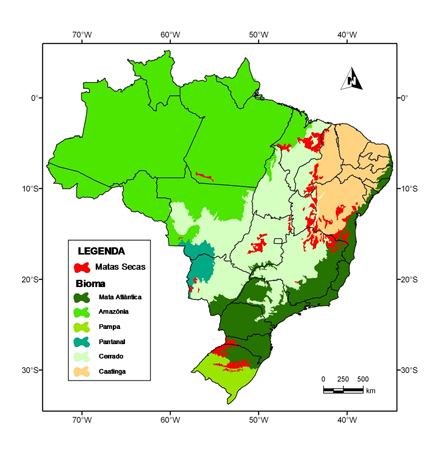 |
| Map showing the distribution of tropical dry forests in Brazil (in red) in various biomes. Image by Arturo Sanchez-Azofeifa |
Loss of these forests would have posed a serious threat to biodiversity and ecosystem services, including weather regulation and water production in Brazil's second-largest watershed, the Sao Francisco River.
Tropi-Dry is led by Arturo Sanchez-Azofeifa of the University of Alberta in Canada. It brings together researchers in conservation biology, ecology, remote sensing and geographic information systems, sociology, anthropology, policy analysis and forestry to develop a "state of the art" understanding of tropical dry forests in the Americas.
The project is funded by the Inter-American Institute (IAI), an intergovernmental organization supported in large part by the U.S. National Science Foundation (NSF).
"This effort clarified a forest area's classification in a way that brought it back under the purview of existing laws in Brazil and led to the protection of an endangered biome," says Paul Filmer, NSF program director for IAI, which is funded by NSF's Directorate for Geosciences.
A biome is an ecosystem characterized by distinctive plant and animal species that have developed and are maintained under specific soil and regional climatic conditions.
"The emphasis on preservation of the Amazonian biome--over the many other biomes present in South America--has led to the exploitation of neglected areas," Filmer says. "This is a major loss, as there are many critical ecological functions carried out by other biomes, functions that buffer the human-inhabited areas they surround."
Although tropical dry forests may receive significant rainfall each year, they have long dry seasons that last several months, causing many of the trees to drop their leaves.
Seasonal droughts drive the workings of tropical dry forests and have widespread effects on all living things there, says Sanchez-Azofeifa.
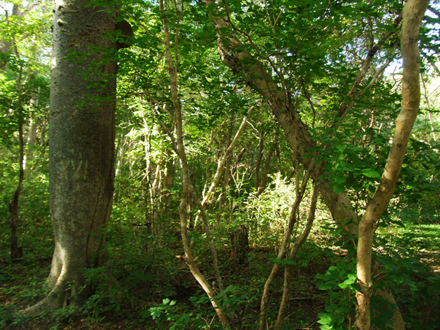 |
| A Brazilian tropical dry forest during the rainy season, which can last 4-6 months. |
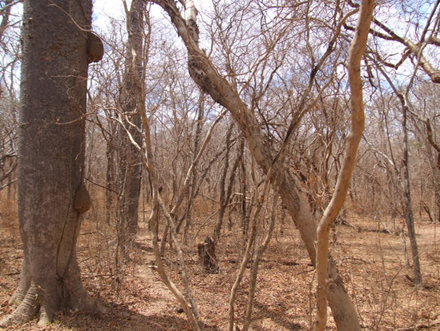 |
| The same forest during the pronounced dry season, when plants lose up to 95% of their leaves. Photograph by Diego Brandao |
Though less biologically diverse than rainforests, tropical dry forests are home to a wide variety of wildlife, including monkeys, deer, large members of the cat family, parrots and ground-dwelling birds. Mammal numbers are higher in tropical dry forests than in rainforests.
Brazil's tropical dry forests contain several hundred nitrogen-fixing leguminous tree species. Many of these species display unique adaptations to a more challenging climate.
The court's decision is a significant victory for the protection of this and other endangered ecosystems outside the Amazon Basin, says Sanchez-Azofeifa. The decision opens the door for future conservation strategies that protect tropical dry forests in Brazil and elsewhere.
The state law would have allowed a 70 percent clearing of Minas Gerais' forests for economic purposes, and would have provided limited, temporary fiscal benefits to a handful of large investors, researchers found.
The court's ruling was strongly influenced by ecological, remote sensing and socio-ecological data provided by Sanchez-Azofeifa and Mario Marcos do Espirito Santo of the Universidad Estadual de Montes Claros, Minas Gerais, Brazil.
These data provided convincing evidence that the forests re-designated under the state law are protected by Brazil's federal law, which takes precedence.
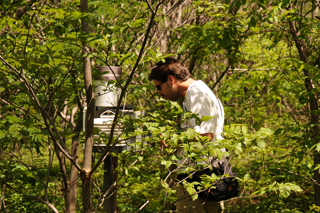 |
| Brazilian scientist checks an understory micro-meteorological station in Mata Seca, Brazil. |
"Many years of ecological and social science research conducted by Tropi-Dry project members and aimed at understanding the human and ecological dimensions of the Minas Gerais biome, clearly show that these forests belong in the federally protected category," says Sanchez-Azofeifa.
"With the substantial documentation we provided, lawyers were able to present a convincing argument that federal protection should extend to these forests," says Marcos do Espirito Santo.
"Once the scientific data had established that the dry forest of Minas Gerais is an extension of the Atlantic forest, federal precedence could be asserted," says Santo. "The Tropi-Dry data were key to this success."
"It's the IAI's mandate to fund research that provides sound scientific knowledge on issues of global change," says Holm Tiessen, director of the IAI.
"The information provided to the appeals court is an excellent example of the need for such data: complex issues related to biodiversity, ecosystem function and the sustainability of the coupled natural-human environment were analyzed and presented to the court in such a way that informed decision-making was possible. "
It's particularly heartening, Tiessen says, "that it was possible to draw attention to the fate of an ecosystem and the services it provides, that's far away from the much-debated tropical rainforest."
Indeed, not all forests in the tropics are rain-soaked. Many of the most important tropical forests, this research shows, are dry.
Their loss would leave behind little but thorny shrublands, thickets or arid grasslands, with significant climate and food security issues for highly populated areas in the Americas.
"The U.N. has designated 2011 as the Year of Forests," says Filmer. "Through the efforts of the IAI and projects like Tropi-Dry, tropical dry forests may become as well-known as their rainforest counterparts."
Tropi-Dry's research sites include the Serra do Cipo National Park and Parque Estadual da Mata Seca in Minas Gerais, Brazil and Patos in Pernambuco, Brazil; the Santa Rosa National Park in Costa Rica; the Chamela-Cuixmala Biosphere Reserve in Mexico and the Hato Pinero in Venezuela.
Related Websites:
Tropi-Dry Project: http://tropi-dry.eas.ualberta.ca
Inter-American Institute: http://www.iai.int/
U.N. Year of Forests: http://www.un.org/en/events/iyof2011/
This news is from the National Science Foundation 18 April 2011.
Search
Latest articles
Agriculture
- World Water Week: Healthy ecosystems essential to human health: from coronavirus to malnutrition Online session Wednesday 24 August 17:00-18:20
- World Water Week: Healthy ecosystems essential to human health: from coronavirus to malnutrition Online session Wednesday 24 August 17:00-18:20
Air Pollution
- "Water and Sanitation-Related Diseases and the Changing Environment: Challenges, Interventions, and Preventive Measures" Volume 2 Is Now Available
- Global Innovation Exchange Co-Created by Horizon International, USAID, Bill and Melinda Gates Foundation and Others
Biodiversity
- It is time for international mobilization against climate change
- World Water Week: Healthy ecosystems essential to human health: from coronavirus to malnutrition Online session Wednesday 24 August 17:00-18:20
Desertification
- World Water Week: Healthy ecosystems essential to human health: from coronavirus to malnutrition Online session Wednesday 24 August 17:00-18:20
- UN Food Systems Summit Receives Over 1,200 Ideas to Help Meet Sustainable Development Goals
Endangered Species
- Mangrove Action Project Collaborates to Restore and Preserve Mangrove Ecosystems
- Coral Research in Palau offers a “Glimmer of Hope”
Energy
- Global Innovation Exchange Co-Created by Horizon International, USAID, Bill and Melinda Gates Foundation and Others
- Wildlife Preservation in Southeast Nova Scotia
Exhibits
- Global Innovation Exchange Co-Created by Horizon International, USAID, Bill and Melinda Gates Foundation and Others
- Coral Reefs
Forests
- NASA Satellites Reveal Major Shifts in Global Freshwater Updated June 2020
- Global Innovation Exchange Co-Created by Horizon International, USAID, Bill and Melinda Gates Foundation and Others
Global Climate Change
- It is time for international mobilization against climate change
- It is time for international mobilization against climate change
Global Health
- World Water Week: Healthy ecosystems essential to human health: from coronavirus to malnutrition Online session Wednesday 24 August 17:00-18:20
- More than 400 schoolgirls, family and teachers rescued from Afghanistan by small coalition
Industry
- "Water and Sanitation-Related Diseases and the Changing Environment: Challenges, Interventions, and Preventive Measures" Volume 2 Is Now Available
- Global Innovation Exchange Co-Created by Horizon International, USAID, Bill and Melinda Gates Foundation and Others
Natural Disaster Relief
- STOP ATTACKS ON HEALTH CARE IN UKRAINE
- Global Innovation Exchange Co-Created by Horizon International, USAID, Bill and Melinda Gates Foundation and Others
News and Special Reports
- World Water Week: Healthy ecosystems essential to human health: from coronavirus to malnutrition Online session Wednesday 24 August 17:00-18:20
- STOP ATTACKS ON HEALTH CARE IN UKRAINE
Oceans, Coral Reefs
- World Water Week: Healthy ecosystems essential to human health: from coronavirus to malnutrition Online session Wednesday 24 August 17:00-18:20
- Mangrove Action Project Collaborates to Restore and Preserve Mangrove Ecosystems
Pollution
- Zakaria Ouedraogo of Burkina Faso Produces Film “Nzoue Fiyen: Water Not Drinkable”
- "Water and Sanitation-Related Diseases and the Changing Environment: Challenges, Interventions, and Preventive Measures" Volume 2 Is Now Available
Population
- "Water and Sanitation-Related Diseases and the Changing Environment: Challenges, Interventions, and Preventive Measures" Volume 2 Is Now Available
- "Water and Sanitation-Related Diseases and the Changing Environment: Challenges, Interventions, and Preventive Measures" Volume 2 Is Now Available
Public Health
- Honouring the visionary behind India’s sanitation revolution
- Honouring the visionary behind India’s sanitation revolution
Rivers
- World Water Week: Healthy ecosystems essential to human health: from coronavirus to malnutrition Online session Wednesday 24 August 17:00-18:20
- Mangrove Action Project Collaborates to Restore and Preserve Mangrove Ecosystems
Sanitation
- Honouring the visionary behind India’s sanitation revolution
- Honouring the visionary behind India’s sanitation revolution
Toxic Chemicals
- "Water and Sanitation-Related Diseases and the Changing Environment: Challenges, Interventions, and Preventive Measures" Volume 2 Is Now Available
- Actions to Prevent Polluted Drinking Water in the United States
Transportation
- "Water and Sanitation-Related Diseases and the Changing Environment: Challenges, Interventions, and Preventive Measures" Volume 2 Is Now Available
- Urbanization Provides Opportunities for Transition to a Green Economy, Says New Report
Waste Management
- Honouring the visionary behind India’s sanitation revolution
- Honouring the visionary behind India’s sanitation revolution
Water
- Honouring the visionary behind India’s sanitation revolution
- Honouring the visionary behind India’s sanitation revolution
Water and Sanitation
- Honouring the visionary behind India’s sanitation revolution
- Honouring the visionary behind India’s sanitation revolution

